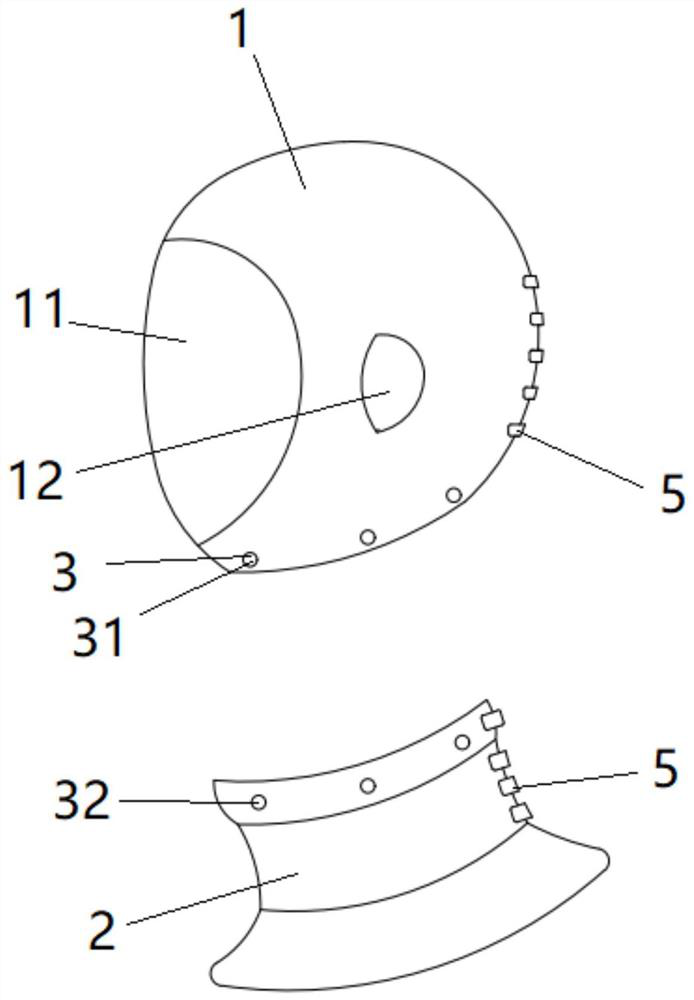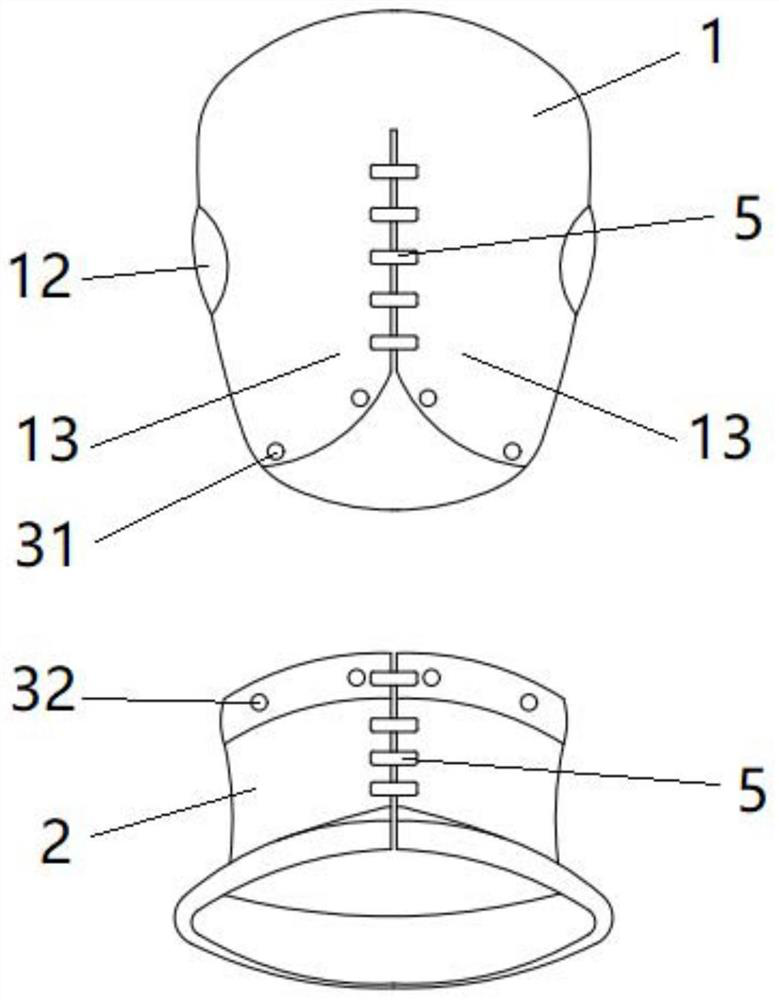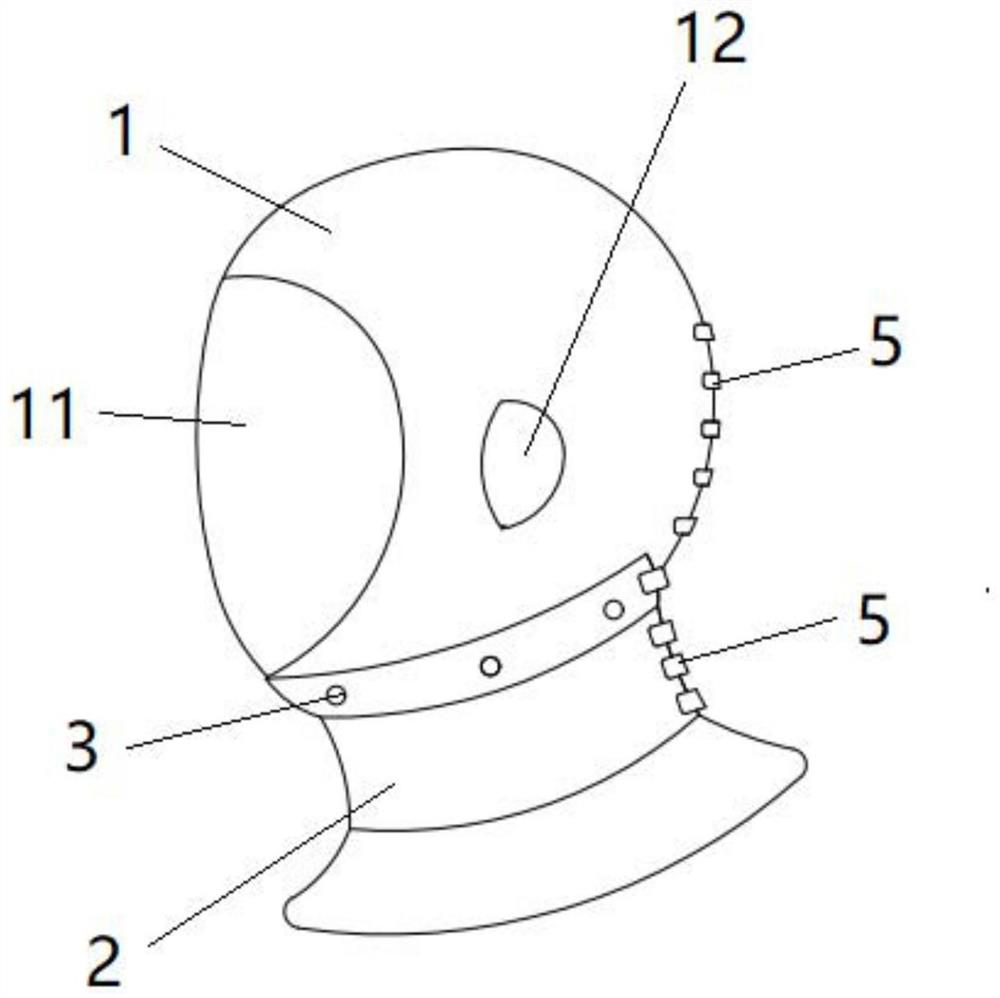Head and neck braking tool used after oral flap transplantation operation and wearing method of tool
A head and neck technology, applied in the field of head and neck braking devices after oral flap transplantation, can solve the problems of prolonging the hospital stay, negative psychological emotions, and discomfort of patients, so as to reduce the difficulty of nursing and avoid Complications, the effect of accelerating recovery
- Summary
- Abstract
- Description
- Claims
- Application Information
AI Technical Summary
Problems solved by technology
Method used
Image
Examples
Embodiment 1
[0045] Such as figure 1 , figure 2 and image 3 As shown, this embodiment provides a head and neck braking device after oral flap transplantation, which is composed of a head restraint 1 , a neck restraint 2 and a braking connector 3 . The patient's head is tightened by the head restraint 1 to achieve the effect of synchronous rotation of the head restraint 1 and the patient's head. The effect of synchronous rotation. After the head restraint 1 and the neck restraint 2 are fixedly connected through the brake connecting piece 3, the relative static effect of the head restraint 1 and the neck restraint 2 can be realized, thereby facilitating the keeping of the patient's head and neck relative to each other. Still effect. Through the widened neck restraint device 2, the bottom of the neck restraint 2 can be used to touch the patient's clavicle, which can produce the effect of limit support, further reduce the range of motion of the patient's neck, and is more conducive to ke...
Embodiment 2
[0054] In this embodiment, on the basis of Embodiment 1, a locator 4 is added to connect the patient's head, neck and back, and the locator 4 based on the back is used to enhance the positioning of the patient's head and neck. Constraint. It enables the patient to better maintain the relative stillness of the head and neck during the exercise process of getting out of bed, so as to avoid affecting postoperative recovery.
[0055] Such as Figure 5 , Figure 6 and Figure 7 As shown, the positioner 4 is composed of a positioning plate 41, two positioning rods 42 and two straps 43; the two ends of the two straps 43 are respectively fixed on both sides of the positioning plate 41, and the patient carries the positioning plate 41 on the back through the straps 43. Fixed, the two positioning rods 42 are parallel to each other and fixed on the top of the positioning plate 41 side by side, the head restraint 1 and the neck restraint 2 are respectively connected to the two position...
Embodiment 3
[0057] On the basis of Example 2, this embodiment provides a method for wearing a head and neck brake device after oral flap transplantation, such as Figure 5 , Figure 6 and Figure 7 As shown, the implementation steps are as follows:
[0058] Step 1: Tear off the Velcro 5 on the back occipital of the head restraint 1 and open the two folded parts 13, the patient's head is inserted into it, the face corresponds to the facial opening 11, and the two outer auricles extend from the ear openings 12 on both sides After the adjustment is completed, turn the two folded parts 13 over and close and attach the Velcro 5, and adjust the tightening force of the head restraint 1 through the sticking position of the Velcro 5 to ensure that the patient's head is in the head restraint 1. It cannot be moved.
[0059] Step 2: According to the length of the patient's neck, choose a neck restraint device 2 with a suitable width, surround the patient's neck, put the bottom of the neck restrain...
PUM
 Login to View More
Login to View More Abstract
Description
Claims
Application Information
 Login to View More
Login to View More - R&D
- Intellectual Property
- Life Sciences
- Materials
- Tech Scout
- Unparalleled Data Quality
- Higher Quality Content
- 60% Fewer Hallucinations
Browse by: Latest US Patents, China's latest patents, Technical Efficacy Thesaurus, Application Domain, Technology Topic, Popular Technical Reports.
© 2025 PatSnap. All rights reserved.Legal|Privacy policy|Modern Slavery Act Transparency Statement|Sitemap|About US| Contact US: help@patsnap.com



